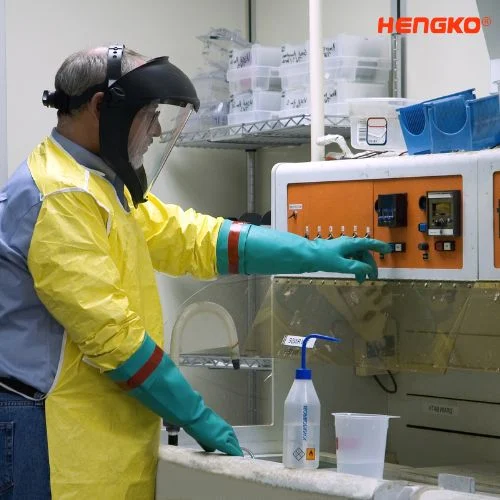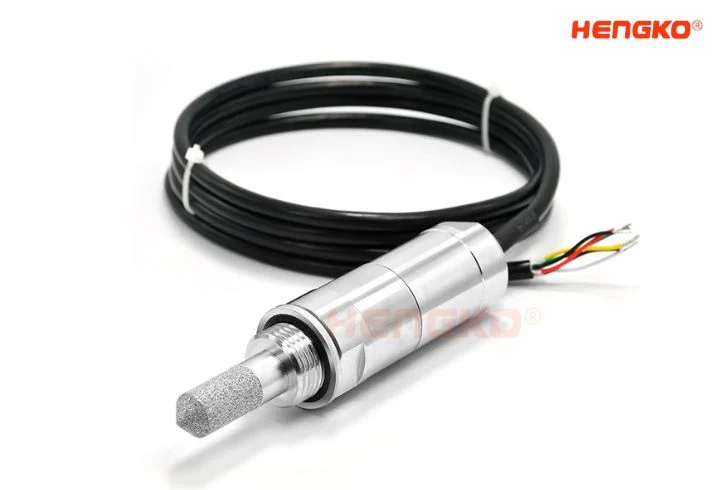Cleanroom Temperature & Humidity Monitoring
Ensuring Optimal Conditions for Precision and Compliance of Ceanroom
ホーム " Cleanroom Temperature and Humidity Monitoring
Wide Humidity Transmitter to Solve Your Cleanroom Humidity Monitoring Problems
Comprehensive Solutions for Effective Cleanroom Humidity Control
To Solve Your Cleanroom Humidity Monitoring Problems by HENGKO’s Wide Humidity Transmitter Option
Maintaining optimal humidity levels in cleanrooms is crucial for ensuring product quality, safety, and compliance with industry standards. HENGKO offers a comprehensive solution to your cleanroom humidity monitoring needs with our wide range of humidity transmitters.
Benefits of Using HENGKO’s Humidity Transmitters:
- Enhanced Product Quality: By maintaining precise humidity levels, our transmitters help prevent contamination and ensure the integrity of sensitive products.
- Improved Compliance: Our transmitters aid in meeting stringent regulatory requirements, providing peace of mind and reducing the risk of non-compliance.
- Cost Efficiency: With reliable performance and low maintenance needs, HENGKO’s humidity transmitters offer a cost-effective solution for cleanroom humidity monitoring.
HENGKO’s wide humidity transmitter options are the ideal choice for tackling cleanroom humidity monitoring challenges. Trust HENGKO to deliver the accuracy, reliability, and performance you need to maintain the highest standards in your cleanroom environment.
Several Probe Humidity Sensor Option - HG808 to Montoring Temp and Humidity. Dew Ponit for Cleanroom.
主な特徴
*The HG808 Air Duct Series Transmitter is equipped with a sensitive waterproof and anti fine dust high-temperature probe, with a temperature range of -60~60 ℃.
*標準的な産業インターフェイスRS485デジタル信号を採用することは表示機能の置かれるか、または4-20 mAのアナログ出力、現場のデジタル表示装置のメートル、PLC、頻度コンバーター、産業制御ホストおよび他の装置に接続することができる。
露点 + Modbus RS485 両出力
シンプルでエレガントなデザイン
工業用グレードのESD安全保護と電源逆接続防止設計
防水・防塵・耐高温プローブの使用
▪高感度防水・防塵高温プローブ
標準 RS485 Modbus RTU 通信プロトコル
高精度、高安定性、LP66 防水・防塵レベル
複数のプローブ材料が使用可能
Duct Humidity Temperature Sensor
HENGKO offers a wide range of temperature and humidity sensors for every need, from stainless steel temperature and humidity sensor probes to dew point transmitters. Our sensors are accurate, reliable, and durable, making them ideal for a wide range of applications
4.1 Dew Point RS485 - Integrated Duct Probe Series
HENGKO offers a wide range of temperature and humidity sensors for every need, from stainless steel temperature and humidity sensor probes to dew point transmitters. Our sensors are accurate, reliable, and durable, making them ideal for a wide range of applications
What Process of Cleanroom need to Monitor Temperature and Humidity ?
All cleanrooms need to monitor temperature and humidity. This is because temperature and humidity can affect:
- Yield: Improper temperature and humidity levels can damage products being manufactured in the cleanroom.
- Quality: Incorrect temperature and humidity can cause inconsistencies in the manufacturing process, leading to lower quality products.
- Comfort: Extreme temperatures and humidity levels can make it uncomfortable for workers, which can lead to errors.
Here are some additional points to consider:
- Standards: ISO 14644 sets forth guidelines for cleanroom classifications. These classifications include recommended temperature and humidity ranges.
- Specific processes: Some processes within a cleanroom may have even more specific requirements for temperature and humidity.

5-Factors You Should Care When Choose Humidity Transmitter for Your Cleanroom Monitoring ?
Here are 5 factors you should consider when choosing a humidity transmitter for your cleanroom monitoring:
正確さ: This is the most important factor to consider. You need a transmitter that can measure humidity levels accurately over the entire range that will be used in your cleanroom.
応答時間 This is the amount of time it takes for the transmitter to respond to changes in humidity levels. You need a transmitter with a fast response time so that you can take corrective action quickly if necessary.
Long-term stability: Over time, all transmitters can drift and become less accurate. You need a transmitter that is stable and will not require frequent calibration.
キャリブレーション: Speaking of calibration, you need to consider how often the transmitter will need to be calibrated and how easy it is to calibrate.
コストだ: The cost of the transmitter is obviously a factor to consider. However, you should not sacrifice accuracy, response time, or stability for a lower price.
よくあるご質問
Why is temperature and humidity monitoring critical in cleanrooms?
Maintaining consistent and precise temperature and humidity levels is essential in cleanrooms for several reasons:
Product Yield and Quality: Improper temperature and humidity can negatively impact the manufacturing process of sensitive materials and products commonly found in cleanrooms. Delicate components used in electronics or pharmaceuticals can be damaged by fluctuations in temperature or excessive moisture. Inconsistent humidity can also lead to static discharge, which can damage sensitive electronic components.
Process Control: Many cleanroom processes are highly sensitive to temperature and humidity variations. For example, in microchip fabrication, even slight temperature changes can cause dimensional variations in the circuits. Precise humidity control is also crucial for processes like photolithography, which uses light-sensitive materials.
Worker Comfort and Safety: Extreme temperatures and humidity levels can create an uncomfortable work environment for cleanroom personnel. Discomfort can lead to fatigue, reduced concentration, and an increased risk of errors. Additionally, high humidity can promote the growth of mold and mildew, which can pose health risks.
What standards or guidelines exist for temperature and humidity in cleanrooms?
ISO 14644 is the international standard that outlines the classification of cleanrooms based on airborne particle concentration. This standard provides recommended ranges for temperature and humidity for different cleanroom classifications. However, it’s important to remember that these are recommendations, and specific processes within a cleanroom may have even tighter requirements. Consulting the technical specifications for the products or processes being conducted in the cleanroom is vital to determine the most appropriate temperature and humidity levels.
What are the key factors to consider when choosing a temperature and humidity monitoring system for a cleanroom?
Several factors come into play when selecting a monitoring system for your cleanroom:
正確さ: This is paramount. Your system needs to deliver highly accurate measurements of both temperature and humidity across the entire range required for your specific cleanroom environment.
応答時間: A fast response time ensures timely detection of any fluctuations in temperature or humidity. This allows for quick corrective actions to be taken before they can impact product yield or quality.
Data Logging and Alerting: The ability to continuously log data and generate alerts when pre-defined thresholds are breached is crucial. This data can be used for trend analysis, ensuring consistent environmental conditions and identifying potential issues before they escalate.
Sensor Suitability: Select sensors specifically designed for cleanroom environments. These sensors should be constructed from materials that are compatible with cleanroom cleaning protocols and not prone to particle shedding.
Wireless vs. Wired Systems: Wireless systems offer greater flexibility in terms of placement, but wired systems may provide a more reliable connection and be less susceptible to interference. Consider your cleanroom layout and prioritize data security needs when making this choice.
Scalability: If you anticipate expanding your cleanroom operations in the future, choose a monitoring system that can be easily scaled to accommodate additional sensors and data points.
What are some best practices for cleanroom temperature and humidity monitoring?
Strategic Sensor Placement: Place sensors in critical locations throughout the cleanroom, considering potential sources of temperature or humidity variations like air handling units, doorways, and equipment.
Calibration and Maintenance: Regularly calibrate your sensors according to the manufacturer’s recommendations to ensure accuracy. Develop a preventative maintenance plan for your monitoring system to maintain optimal performance.
Data Analysis and Review: Routinely analyze the data collected by your monitoring system. Look for trends, identify potential issues, and take corrective actions when necessary. Data analysis can also help you optimize your cleanroom environment for improved process control and product quality.
Documentation and Record Keeping: Maintain detailed records of calibration certificates, maintenance logs, and sensor data. This documentation is essential for regulatory compliance and helps demonstrate your commitment to maintaining a controlled environment.
FIND RIGHT TEMPERATURE & HUMIDITY TRANSMITTER
今すぐプロジェクトをお知らせください
モニタープロジェクトの詳細をお聞かせください、
私たちは3日以内に競争力のある価格で最高のソリューションを提供します。
私たちは3日以内に競争力のある価格で最高のソリューションを提供します。

スプレッド・ザ・ワールド
HENGKOは、産業用センサーソリューションのグローバルリーダーであり、ユニークなデザインと優れた性能に定評があります。当社の温度・湿度トランスミッターとセンサーは、食品・飲料、製薬、製造、環境モニタリングなど、幅広い産業分野で使用されています。
0
+
経験年数
0
世界販売
0
K







